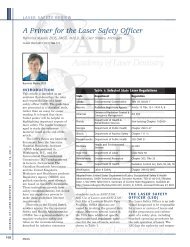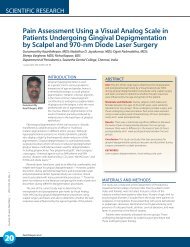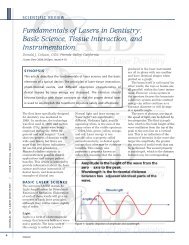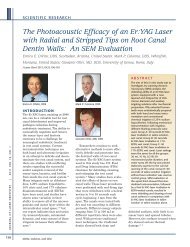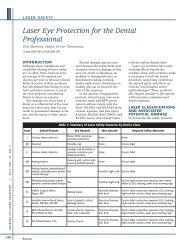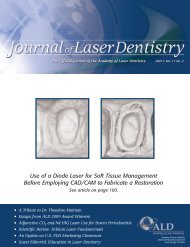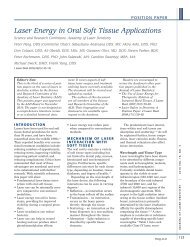Create successful ePaper yourself
Turn your PDF publications into a flip-book with our unique Google optimized e-Paper software.
J O U R N A L O F L A S E R D E N T I S T R Y | 2 011 V O L . 19 , N O . 3<br />
304<br />
R E S E A R C H A B S T R A C T S<br />
L A S E R - M O D I F I E D T I TA N I U M I M P L A N T S F O R I M P R O V E D C E L L A D H E S I O N<br />
Andreas Heinrich, Katrin Dengler, Timo Koerner,<br />
Cornelia Haczek, Herbert Deppe, and Bernd Stritzker<br />
Concerning dental implant systems, a main problem is<br />
the adhesion <strong>of</strong> peri-implant mucosa in the cervical<br />
region. The aim <strong>of</strong> the present study was to use a laser<br />
for modifying titanium implants to promote mucosal<br />
adhesion, which is indispensable as a biological barrier<br />
against bacterial infection. By the use <strong>of</strong> a KrF excimer<br />
laser, it was possible to induce a holey structure on the<br />
polished area <strong>of</strong> the implant surface, which was<br />
analysed by a scanning electron microscope. In addi-<br />
Peri-implantitis is considered to be a multifactorial<br />
process involving bacterial contamination <strong>of</strong> the<br />
implant surface. A previous study demonstrated that a<br />
combination <strong>of</strong> toluidine blue O (100 microgram/ml)<br />
and irradiation with a diode s<strong>of</strong>t laser with a wavelength<br />
<strong>of</strong> 905 nm results in an elimination <strong>of</strong><br />
Porphyromonas gingivalis (P. gingivalis), Prevotella<br />
intermedia (P. intermedia), and Actinobacillus actinomycetemcomitans<br />
(A. actinomycetemcomitans) on<br />
different implant surfaces (machined, plasma-flamesprayed,<br />
etched, hydroxyapatite-coated). The aim <strong>of</strong> this<br />
study was to examine the laser effect in vivo. In 15<br />
patients with IMZ implants who showed clinical and<br />
radiographic signs <strong>of</strong> peri-implantitis, toluidine blue<br />
Universität Augsburg, Augsburg, Germany<br />
<strong>Laser</strong>s Med Sci 2008;23(1):55-58<br />
tion, the attachment <strong>of</strong> fibroblast cells to the created<br />
structures was investigated with the aid <strong>of</strong> an environmental<br />
scanning electron microscope. It turned out that<br />
the cells preferentially attach to the holey structure.<br />
Thereby, the cells form bridges inside, leading to a<br />
complete covering <strong>of</strong> the hole. In this way, a more effective<br />
biological barrier against bacteria can be created.<br />
Copyright 2008 Springer nn<br />
L E T H A L P H OTO S E N S I T I Z AT I O N F O R D E C O N TA M I N AT I O N O F I M P L A N T<br />
S U R FA C E S I N T H E T R E AT M E N T O F P E R I - I M P L A N T I T I S<br />
Orhun Dörtbudak, Robert Haas, Thomas Bernhart, Georg Mailath-Pokorny<br />
University <strong>of</strong> Vienna, Vienna, Austria<br />
Clin Oral Implants Res 2001;12(2):104-108<br />
O was applied to the implant surface for 1 min and the<br />
surface was then irradiated with a diode s<strong>of</strong>t laser with<br />
a wavelength <strong>of</strong> 690 nm for 60 s. Bacterial samples<br />
were taken before and after application <strong>of</strong> the dye and<br />
after lasing. The cultures were evaluated semiquantitatively<br />
for A. actinomycetemcomitans, P. gingivalis, and<br />
P. intermedia. It was found that the combined treatment<br />
reduced the bacterial counts by 2 log steps on<br />
average. The application <strong>of</strong> TBO and laser resulted in a<br />
significant reduction (P < 0.0001) <strong>of</strong> the initial values<br />
in all 3 groups <strong>of</strong> bacteria. Complete elimination <strong>of</strong><br />
bacteria was not achieved.<br />
Copyright 2001 Blackwell Publishing and the European<br />
Association for Osseointegration nn





